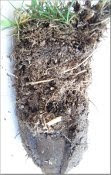Then, one day, I noticed some growth. Not where it should be, in the centre of the lawn, but around the edges. Recent heavy rain had moistened the borders around the lawn. The problem seemed to be water. The edges had soaked up water from the borders.
But how could it be water? Apart from that month, it had been raining since the previous autumn. It couldn't possibly be short of water, could it?
It was. When I dug through the surface, the soil was bone dry, set like concrete underneath. I could not believe my eyes.
 Then I looked at the inch and a half of thatch which was standing between the soil and the rainwater. It too was bone dry.
Then I looked at the inch and a half of thatch which was standing between the soil and the rainwater. It too was bone dry.I got a fork and forced it down through the thatch (It was so hard I had to jump on the fork. It is like this again, now) and stirred it around. In fact, I had to move the fork around just to get it in. I did this all over, then filled up the holes with water. After this, further water went in as if by magic. It hardly seemed to take any water to wet the deeper layers, whereas I had had the sprinkler running for hours before. Amazing.
This problem is called 'Compaction'. Of course, I had heard of it, but thought it was caused by children playing on muddy turf. I had no idea that it applied to almost every lawn in the country. Yes, it will apply to yours as well. Give it a test.
TEST FOR COMPACTION
If you can easily push a garden fork into the surface to full depth on a dry lawn, then things are O.K. If you can't, then there is a problem. The fork is the test. It never fails.
 The tool on the left is a hollow-tiner. You push it into the soil and it takes out plugs to let in air and water. There are mechanical versions if this seems like too much work. Professional lawn companies will do it for you. But it's expensive. And it only lasts two or three years.
The tool on the left is a hollow-tiner. You push it into the soil and it takes out plugs to let in air and water. There are mechanical versions if this seems like too much work. Professional lawn companies will do it for you. But it's expensive. And it only lasts two or three years.
No comments:
Post a Comment